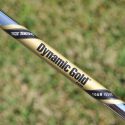 Need new alignment sticks? Here are 15 cool, clean styles to pick from
Need new alignment sticks? Here are 15 cool, clean styles to pick from
When should you consider tipping a golf shaft? Follow this handy guide

Most conversations about tipping tend to revolve around how much cash you should leave on the table after you’ve eaten at a restaurant. Or how bad Matt Kuchar is at doing it. But, when it comes to golf club science, tipping is a whole different thing.
While practically every golf club fitting guru and gearhead knows what it means to “tip” a clubshaft, most golfers don’t know what it is or what kind of effect it can have on how a club performs. “Tipping” or “tip trimming,” as it’s sometimes called, means trimming a club shaft from the clubhead end, not from the grip end where it’s most often cut.
Ok, so what?
When you tip a shaft — which by the way, you need to have parallel shafts to do this — you alter how the shaft performs by making it slightly stiffer and increasing torque for less twisting through impact.
Better players tend to make the most use of this technique in order to fine-tune their shafts to precisely the amount of flex and feel they’re looking for. And sure, they could just as well switch to a different shaft, but tipping affords even greater fine-tuning to a particular flex profile. In most cases, shaft tipping is done to steel iron and wedge shafts but occasionally is done in graphite shafts for woods and drivers as well.
Lastly, tipping won’t do much to affect spin rates and launch angle — two popular misconceptions when it comes to trimming the lower end of a shaft.
How much should you tip?
This depends on what you’re looking for. The more you cut off, the more you change the flex profile (towards a stiffer shaft). Some shaft manufacturers actually list tipping guidelines on their websites to help you discern the right amount to cut.
Wait, what are parallel shafts again?
A parallel shaft is one that has a constant diameter from the tip and up to a specified distance on the shaft. Conversely, a taper tip is as it’s described — the shaft tapers towards the tip. Most new clubs (irons and woods) are designed to accommodate parallel shafts, but can also accommodate a taper shaft using brass adapter shims.
ADVERTISEMENT
How does tipping differ from “shaft stepping”?
Shaft stepping, another common practice seen usually among better players, means altering your club’s shaft profile by offsetting your shafts based on what iron they’re designed for. A “hard step” is to put a 5-iron shaft into a 4-iron clubhead and so on through the set. This makes the shaft play a little stiffer. A “soft step” is the opposite — it means putting a 3-iron shaft into a 4-iron head (and so on through the set) to make the shaft play a little softer.
To receive GOLF’s all-new newsletters, subscribe for free here.
ADVERTISEMENT







